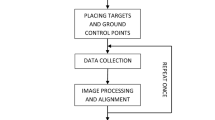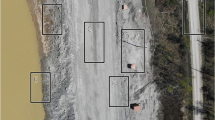Abstract
To reduce accidents caused by slope failures, disaster assessments and displacement measurements of steep slopes are conducted. Measurement values can vary greatly, depending on the technician’s proficiency. Moreover, land creep and minute displacements are difficult to detect. In this study, we attempted to solve this problem using unmanned aerial vehicles (UAVs) and aerial triangulation. After a review of previous studies, a measurement precision of 10 cm for daily monitoring and sub-centimeters for precise monitoring were set. Twelve checkpoints were used, and the comparison results between the measured values using the total station and the aerial triangulation using the UAV were as follows. A virtual reference station (VRS) and three ground control points (GCPs) yielded 11.58 mm for the 3D (root-mean-square error) RMSE, and post-processed kinematic (PPK) and three GCPs generated 9.71 mm. By differentiating the results of multiple observations, the PPK processing results could achieve sub-centimeter accuracy. We verified that direct georeferencing using a VRS is sufficient for daily monitoring, and precise measurements require at least three GCPs. Geotechnicians can use VRS observations for economical slope monitoring in normal times, and accurate observations with GCPs when precise measurements are required.
Similar content being viewed by others
References
Al M (2020) Application of the spatial prediction modeling approach for landslide susceptibility mapping and risk evaluation. PhD Thesis, University of Kongju, Kongju, Korea
Bazin S (2012) Safe land guidelines for landslide monitoring and early warning systems in europe-design and required technology. Proceedings of the conference on EGU general assembly 2012, April 22–27, Vienna, Austria
Cha KS, Kim TH (2011) Evaluation of slope stability with topography and slope stability analysis method. KSCE Journal of Civil Engineering 15(2):251–256, DOI: https://doi.org/10.1007/s12205-011-0930-5
Cheon DJ, Park YJ, Lee SH, Kim JS, Jung DY (2013) The development of landslide predictive system using measurement information based on u-IT. Journal of the Korea Academia-Industrial Cooperation Society 14(10):5115–5122, DOI: https://doi.org/10.5762/KAIS.2013.14.10.5115 (in Korean)
Cho HK, Chang KT, Hong SJ, Hong GP, Kim SH, Kwon SH (2020) Accuracy analysis for slope movement characterization by comparing the data from real-time measurement device and 3D model value with drone based photogrammetry. Journal of the Korean Association of Geographic Information Studies 23(4):234–252, DOI: https://doi.org/10.11108/KAGIS.2020.23.4.234 (in Korean)
Choi YN (2019) Estimation of debris-flow volume by field survey and GIS based numerical analysis of the behavior. PhD Thesis, University of Kangwon, Chuncheon, Korea (in Korean)
Choi HJ, Lee BK, Yeon SH (2013) A study on the site calibration of VRS-GNSS surveying. Journal of the Korean Society of Surveying, Geodesy, Photogrammetry and Cartography 31(1):99–107, DOI: https://doi.org/10.7848/KSGPC.2013.31.1.99 (in Korean)
Choi SG, Suk JW, Jeong HS (2021) Suggestion of measurement management criteria for soil slope failure based on displacement. Journal of the Korean Society of Hazard Mitigation 21(1):251–260, DOI: https://doi.org/10.9798/KOSHAM.2021.21.1.251 (in Korean)
Ciampittiello M, Saidi H, Dresti C, Coluccino M, Turconi L, Little WW, Luino F (2021) Landslides along the Lago Maggiore western coast (northern Italy): Intense rainfall as trigger or concomitant cause? Natural Hazards 107(2):1225–1250, DOI: https://doi.org/10.1007/s11069-021-04626-8
Cruden DM, Varnes DJ (1996) Landslides investigation and mitigation, transportation research board. Special Report 247:36–75, In: Turner AK, Schuster RL (eds) Landslide types and process. National Research Council, National Academy Sciences, Washington DC, USA
Dolojan NLJ, Moriguchi S, Hashimoto M, Terada K (2021) Mapping method of rainfall-induced landslide hazards by infiltration and slope stability analysis. Landslides 18:2039–2057, DOI: https://doi.org/10.1007/s10346-020-01617-x
Gavrilets V (1998) Avionics systems development for small unmanned aircraft. MSc Thesis, Massachusetts Institute of Technology, Cambridge, MA, USA
Gerke M, Nex F, Remondino F, Jacobsen K, Kremer J, Karel W, Hu H, Ostrowski W (2016) Orientation of oblique airborne image sets — Experiences from the ISPRS/EUROSDR benchmark on multi-platform photogrammetry. Proceedings of 41th the international archives of photogrammetry, remote sensing and spatial information sciences, July 12–19, Prague, Czech Republic
Gheshlaghi HA, Feizizadeh B (2021) GIS-based ensemble modelling of fuzzy system and bivariate statistics as a tool to improve the accuracy of landslide susceptibility mapping. Natural Hazards 107:1981–2014, DOI: https://doi.org/10.1007/s11069-021-04673-1
Han SH, Hong CK (2020) Accuracy assessment of aerial triangulation of VRS-GNSS UAV. Journal of the Korean Society of Surveying, Geodesy, Photogrammetry and Cartography 38(6):663–670, DOI: https://doi.org/10.7848/KSGPC.2020.38.6.663 (in Korean)
Hungr O, Leroueil S, Picarelli L (2014) The varnes classification of landslide types, an update. Landslides 11:167–194, DOI: https://doi.org/10.1007/s10346-013-0436-y
Hutchinson JN (1988) Morphological and geotechnical parameters of landslides in relation to geology and hydrogeology. Proceedings of 5th international symposium on landslides symposium on landslides, July 10–15, Lausanne, Switzerland
Jacobsen K (1991) Trends in GPS photogrammetry. Technical Papers of ACSM-ASPRS 5:208–217
Jahns RH (1949) Desert floods. Engineering and Science 12(8):10–14
Jam AS, Mosaffaie J, Sarfaraz F, Shadfar S, Akhtari R (2021) GIS-based landslide susceptibility mapping using hybrid MCDM models. Natural Hazards 108:1025–1046, DOI: https://doi.org/10.1007/s11069-021-04718-5
Japan Highways Organization (1998) Design guideline. Japan Highways Organization, Tokyo, Japan
Kim MG (2020) Optimization of three-dimensional geostatistical integration of site investigation information. PhD Thesis, University of Seoul, Seoul, Korea
Kim MS, Bae TS (2020) Evaluation of N-RTK positioning accuracy for moving platform. Journal of the Korean Society of Surveying, Geodesy, Photogrammetry and Cartography 38(3):259–267, DOI: https://doi.org/10.7848/KSGPC.2020.38.3.259 (in Korean)
Kim SS, Kim D, Shin DY, Nho HJ (2020) Assessment and analysis of disaster risk for steep slope using drone and terrestrial LiDAR. Journal of Korean Society for Geospatial Information Science 28(4):13–24, DOI: https://doi.org/10.7319/kogsis.2020.28.4.013 (in Korean)
Lee SW, Jang BS, Kim SH, Heo IY, Hong SP (2012) Analysis of saturation depth by rainfall intensity and soil conditions on slope. Journal of Korean Geosynthetics Society 11(4):63–69, DOI: https://doi.org/10.12814/jkgss.2012.11.4.063 (in Korean)
Lee WY, Park SK, Sung HH (2021) The optimal rainfall thresholds and probabilistic rainfall conditions for a landslide early warning system for Chuncheon, Republic of Korea. Landslides 18(5):1721–1739, DOI: https://doi.org/10.1007/s10346-020-01603-3
Manchado AMT, Allen S, Ballesteros-Canovas JA, Dhakal A, Dhital MR, Stoffel M (2021) Three decades of landslide activity in western Nepal: New insights into trends and climate drivers. Landslides 18:2001–2015, DOI: https://doi.org/10.1007/s10346-021-01632-6
Martha TR, Roy P, Jain N, Khanna K, Mrinalni K, Kumar KV, Rao PVN (2021) Geospatial landslide inventory of India — An insight into occurrence and exposure on a national scale. Landslides 18:2125–2141, DOI: https://doi.org/10.1007/s10346-021-01645-1
Michoud C, Bazin S, Blikra LH, Derron MH, Jaboyedoff M (2013) Experiences from site-specific landslide early warning systems. Natural Hazards and Earth System Sciences 13(10):2659–2673, DOI: https://doi.org/10.5194/nhess-13-2659-2013
Ministry of the Interior and Safety (2015) The R&D research on construction of monitoring management system for evacuating inhabitant in steep slope site and development of monitoring specification. Ministry of the Interior and Safety, Sejong, Korea
Ministry of the Interior and Safety (2016) Guideline of steep-slope management. Ministry of the Interior and Safety, Sejong, Korea
Moe K, Toschi I, Poli D, Lago F, Schreiner C, Legat K, Remondino F (2016) Changing the production pipeline — Use of oblique aerial cameras for mapping purposes. Proceedings of 41st the international archives of photogrammetry, remote sensing and spatial information sciences, July 12–19, Prague, Czech Republic
Naseer S, Haq TU, Khan A, Tanoli JI, Khan NG, Shah STH (2021) GIS-based spatial landslide distribution analysis of district Neelum, AJ&K, Pakistan. Natural Hazards 106(1):965–989, DOI: https://doi.org/10.1007/s11069-021-04502-5
National Geographic Information Institute (2016) Achievement report. National Geographic Information Institute, Suwon, Korea, 1–25
Quan HC, Lee BG (2012) GIS-based landslide susceptibility mapping using analytic hierarchy process and artificial neural network in Jeju (Korea). KSCE Journal of Civil Engineering 16(7):1258–1266, DOI: https://doi.org/10.1007/s12205-012-1242-0
RTKLIB (2013) Manual, ver. 2.4.2. RTKLIB, Retrieved April 29, 2013, http://www.rtklib.com/prog/manual_2.4.2.pdf
Rupnik E, Nex F, Toschi I, Remondino F (2015) Aerial multi-camera systems: Accuracy and block triangulation issues. ISPRS Journal of Photogrammetry and Remote Sensing 101:233–246, DOI: https://doi.org/10.1016/j.isprsjprs.2014.12.020
Saito M (1969) Research on forecasting the time of occurrence of slope failure. Railway Technical Research Institute 10(3):135–142
Salvini R, Mastrorocco G, Esposito G, Di Bartolo S, Coggan J, Vanneschi C (2018) Use of a remotely piloted aircraft system for hazard assessment in a rocky mining area (Lucca, Italy). Natural Hazards and Earth System Sciences 18(1):287–302, DOI: https://doi.org/10.5194/nhess-18-287-2018
Salvini R, Vanneschi C, Coggan JS, Mastrorocco G (2020) Evaluation of the use of UAV photogrammetry for rock discontinuity roughness characterization. Rock Mechanics and Rock Engineering 53(8):3699–3720, DOI: https://doi.org/10.1007/s00603-020-02130-2
Samad AM, Kamarulzaman N, Hamdani MA, Mastor TA, Hashim KA (2013) The potential of unmanned aerial vehicle (UAV) for civilian and mapping application. Proceeding of 3rd international conference on system engineering and technology, August 19–20, Shah Alam, Malaysia
Sara K (2017) Assessment of landslide susceptibility using GIS-based spatial models and Remote sensing data: A case study in Jinbu area, Korea. PhD Thesis, University of Kongju, Kongju, Korea
Seo JP, Kim KD, Woo CS (2019) Analysis on displacement characteristics of slow-moving landslide on a slope near road using the topographic map and airborne LiDAR. Journal of the Korea Academia-Industrial Cooperation Society 20(5):27–35, DOI: https://doi.org/10.5762/KAIS.2019.20.5.27 (in Korean)
Sestras P, Bilaşco Ş, Roşca S, Dudic B, Hysa A, Spalević V (2021) Geodetic and UAV monitoring in the sustainable management of shallow landslides and erosion of a susceptible urban environment. Remote Sensing 13(3):385, DOI: https://doi.org/10.3390/rs13030385
SMG (2021) Information on road slope in Seoul Metropolitan Government. Seoul Metropolitan Government (SMG), Retrieved May 24, 2021, http://data.seoul.go.kr/dataList/OA-15777/S/1/datasetView.do (in Korean)
Taddia Y, Stecchi F, Pellegrinelli A (2020) Coastal mapping using DJI phantom 4 RTK in post-processing kinematic mode. Drones 4(2):9, DOI: https://doi.org/10.3390/drones4020009
Task Committee of Japanese Geotechnical Society (1996) Manual for zonation on rain-induced slope failure. Japanese Geotechnical Society, Tokyo, Japan
Tomaštík J, Mokroš M, Surový P, Grznárová A, Merganič J (2019) UAV VRS/PPK method — An optimal solution for mapping inaccessible forested areas? Remote Sensing 11 (6):721, DOI: https://doi.org/10.3390/rs11060721
Varnes DJ (1978) Landslides: Analysis and control transportation research board. Special Report 176:11–33, National Academy of Sciences, Washington DC, USA
Yoo BS (2006) A study of failure analysis methods based on real-time monitoring data for landslide warning system. PhD Thesis, Kumoh
National Institute of Technology, Gumi, Korea Yueping Y, Wang H, Gao Y, Li X (2010) Real-time monitoring and early warning of landslides at relocated Wushan Town, the Three Gorges Reservoir, China. Landslides 7(3):339–349, DOI: https://doi.org/10.1007/s10346-010-0220-1
Zhang H, Aldana-Jague E, Clapuyt F, Wilken F, Vanacker V, Oost KV (2019) Evaluating the potential of post-processing kinematic (PPK) georeferencing for UAV-based structure-from-motion (SfM) photogrammetry and surface change detection. Earth Surface Dynamics 7(3):807–827, DOI: https://doi.org/10.5194/esurf-7-807-2019
Acknowledgments
Not Applicable
Author information
Authors and Affiliations
Corresponding author
Rights and permissions
About this article
Cite this article
Cho, J., Lee, J. & Lee, B. Application of UAV Photogrammetry to Slope-Displacement Measurement. KSCE J Civ Eng 26, 1904–1913 (2022). https://doi.org/10.1007/s12205-021-1374-1
Received:
Revised:
Accepted:
Published:
Issue Date:
DOI: https://doi.org/10.1007/s12205-021-1374-1




